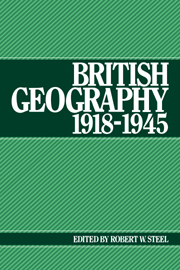Book contents
- Frontmatter
- Contents
- Preface
- 1 The beginning and the end
- 2 Geography during the inter-war years
- 3 Geography in the University of Wales, 1918–1948
- 4 Geography at Birkbeck College, University of London, with particular reference to J. F. Unstead and E. G. R. Taylor
- 5 The Oxford School of Geography
- 6 Geography in the Joint School (London School of Economics and King's College)
- 7 Geography in a University College (Nottingham)
- 8 Geographers and their involvement in planning
- 9 On the writing of historical geography, 1918–1945
- 10 Physical geography in the universities, 1918–1945
- 11 Geographers and geomorphology in Britain between the wars
- 12 British geography, 1918–1945: a personal perspective
- Index
7 - Geography in a University College (Nottingham)
Published online by Cambridge University Press: 07 October 2009
- Frontmatter
- Contents
- Preface
- 1 The beginning and the end
- 2 Geography during the inter-war years
- 3 Geography in the University of Wales, 1918–1948
- 4 Geography at Birkbeck College, University of London, with particular reference to J. F. Unstead and E. G. R. Taylor
- 5 The Oxford School of Geography
- 6 Geography in the Joint School (London School of Economics and King's College)
- 7 Geography in a University College (Nottingham)
- 8 Geographers and their involvement in planning
- 9 On the writing of historical geography, 1918–1945
- 10 Physical geography in the universities, 1918–1945
- 11 Geographers and geomorphology in Britain between the wars
- 12 British geography, 1918–1945: a personal perspective
- Index
Summary
After winning a borough scholarship in 1922 I entered the University College of Southampton. In recent years Southampton had had two well-known men in charge of geography: C. B. Fawcett (1915–19), appointed to a newly created lectureship in the subject, and W. H. Barker (1919–22) who was given a Chair in 1921. As in many other universities at that time they were not trained in geography but came from some other subject or subjects in which they had specialized. Their skills in these rendered their work for geography as varied as their initial training but at least they established a common mode of approach which in turn drew much of its inspiration from the new geographical studies which emerged from Oxford or from the work of such writers as H. R. Mill of the Royal Geographical Society. Fawcett, who had taken a degree in science at the University College of Nottingham, went on to extend his qualifications by taking the invaluable geographical Diploma at Oxford under A. J. Herbertson. Thus he was a singularly well-qualified person for appointment to the new lectureship. In 1918 he published Frontiers: a study in political geography and in the following year there appeared his Provinces of England.
Another advantage for the geography course at Southampton was the presence in the town of the headquarters of the Ordnance Survey, at that time under the direction of Colonel Sir Charles F. Close.
- Type
- Chapter
- Information
- British Geography 1918–1945 , pp. 90 - 99Publisher: Cambridge University PressPrint publication year: 1987



